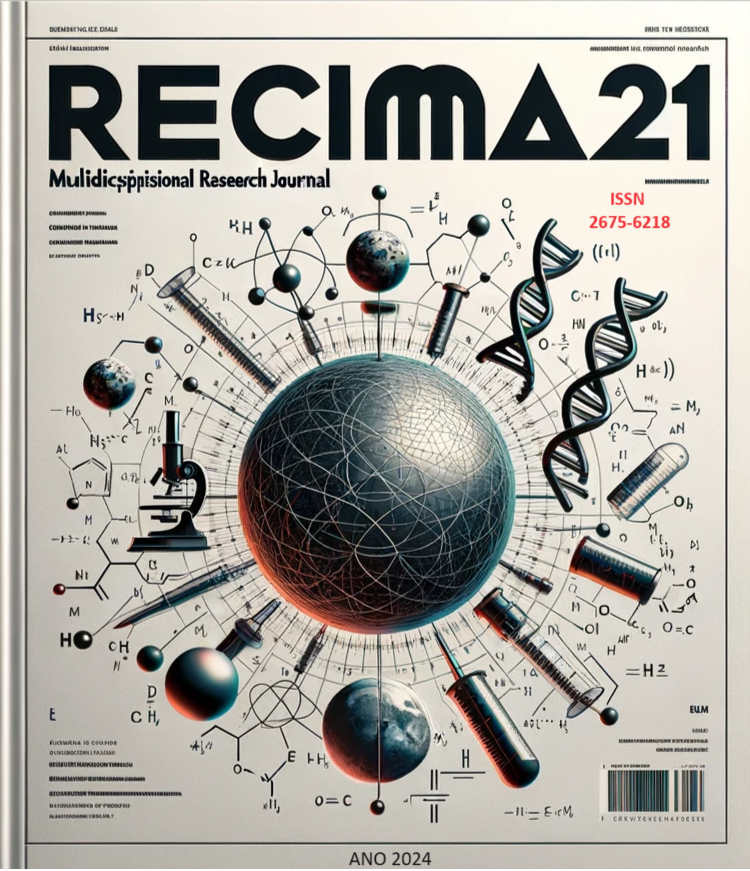REFLEXOS PRIMITIVOS: TERAPIAS OPTOMÉTRICAS
DOI:
https://doi.org/10.47820/recima21.v5i3.5006Palavras-chave:
reflexo primitivos, terapia visual, optometriaResumo
Os reflexos primitivos são parte integrante do mecanismo de sobrevivência de um recém-nascido e irão integrar-se naturalmente durante os primeiros anos de vida à medida que surgem reflexos posturais mais maduros. Quando o reflexo primitivo não é integrado pode ocorrer falha no desenvolvimento das habilidades motoras, no processamento cognitivo e na regulação emocional do indivíduo. A persistência dos reflexos primários pode indicar mau desenvolvimento neurológico e imaturidade do sistema nervoso. Através de revisões bibliográficas demonstra-se correlações de reflexos primitivos retidos e distúrbios nas habilidades no desenvolvimento de crianças. Em um ambiente multidisciplinar, o optometrista é muito importante, uma vez que esse é o agente dos cuidados primários da visão, podendo realizar testes avaliativos e planejar terapias para a integração desses reflexos primitivos proporcionando assim, uma melhor qualidade de vida ao paciente. Mais pesquisas são necessárias sobre a utilidade das técnicas de integração reflexa para melhorar o funcionamento motor, cognitivo e emocional e melhorar a qualidade de vida geral.
Downloads
Referências
ANDRICH, P. et al. Statistical Relationships Between Visual Skill Deficits and Retained Primitive Reflexes in Children. Optometry & Visual Performance, v. 6, n. 3, 2018. https://www.ovpjournal.org/uploads/2/3/8/9/23898265/63c.pdf Acesso em: 05 set. de 2023.
BERNE, Samuel A. The Primitive Reflexes: Considerations in the Infant. Optometry & Vision Development, v. 37, n. 3, 2006. from http://c.ymcdn.com/sites/www.covd.org/resource/resmgr/ovd37-3/139-146berneessay.pdf. Acesso em: 02 nov. 2023.
CENTERS FOR DISEASE CONTROL AND PREVENTION [CDC]. Increasing prevalence of parent-related attention-deficit/hyperactivity disorder among children—United States, 2003 and 2007. Morbidity and Mortality Weekly Report, v. 59, n. 44, p. 1439-1443, 2010. http://www.ncbi.nlm.nih.gov/pubmed/21063274 Acesso em: 04 set. 2023.
DOMINGO-SANZ, Vicente A. Inhibition of Primitive Reflexes and Its Relationship with Visual Projection in Children and Adolescents. Optometry & Visual Performance, v. 10, n. 4, 2022. https://www.oepf.org/wp-content/uploads/2021/01/Web-OVP10-4-Full-Issue.pdf#page=14 Acesso em: 04 set. 2023.
FIORENTINO, Mary R. Reflex Testing Methods for Evaluating CNS Development. American Journal of Physical Medicine & Rehabilitation, v. 53, n. 6, p. 300, 1974. https://journals.lww.com/ajpmr/citation/1974/12000/reflex_testing_methods_for_evaluating_c_n_s_.19.aspx Acesso em: 04 set. 2023.
GIEYSZTOR, Ewa et al. Pelvic symmetry is influenced by asymmetrical tonic neck reflex during young children’s gait. International Journal of Environmental Research and Public Health, v. 17, n. 13, p. 4759, 2020. DOI: https://doi.org/10.3390/ijerph17134759 DOI: https://doi.org/10.3390/ijerph17134759
GODDARD B. S. Attention, Balance and Coordination: The ABC of Learning Success. Chichester, UK: John Wiley and Sons, 2017. Doi: 10.1002/9781119164746. DOI: https://doi.org/10.1002/9781119164746
GODDARD B. S.; DUNCOMBE, R.; PREEDY, P.; GORELY, T. Neuromotor readiness for school: the primitive reflex status of young children at the start and end of their first year at school in the United Kingdom. Education, v. 3, n. 13, p. 1–14, 2021. DOI: 10.1080/03004279.2021.1895276. DOI: https://doi.org/10.1080/03004279.2021.1895276
GONZÁLEZ, Sergio Ramírez et al. The Correlation between Primitive Reflexes and Saccadic Eye Movements in 5th Grade Children with Teacher-Reported Reading Problems. Optometry & Vision Development, v. 39, n. 3, 2008. https://web.p.ebscohost.com/abstract?direct=true&profile=ehost&scope=site&authtype=crawler&jrnl=15574113&asa=Y&AN=34757635&h=oHvQOvrsWmLM0oOnJdl0QsT9uyzRUv57DAEKuK0ncjfpzpwR9CrZ487R8b4RiN7bM3B7qd9U4dT3eeOG5s0JBw%3d%3d&crl=c&resultNs=AdminWebAuth&resultLocal=ErrCrlNotAuth&crlhashurl=login.aspx%3fdirect%3dtrue%26profile%3dehost%26scope%3dsite%26authtype%3dcrawler%26jrnl%3d15574113%26asa%3dY%26AN%3d34757635 Acesso em: 04 set. 2023.
GRZYWNIAK, C. Role of Early-Childhood Reflexes in the Psychomotor Development of a child, and in learning. Acta Neuropsychologica, v. 14, n. 2, 2016. DOI:10.5604/17307503.1213000
KALEMBA, A. et al. The correlation between residual primitive reflexes and clock reading difficulties in school-aged children—A pilot study. International Journal of Environmental Research and Public Health, v. 20, n. 3, p. 2322, 2023. https://doi.org/10.3390/ijerph20032322 DOI: https://doi.org/10.3390/ijerph20032322
KOH, P. S.; RAFFENSPERGER, J. G.; BERRY, S.; LARSEN, M. B.; JOHNSTONE, H. S.; CHOU, P. et al. Long-term outcome in children with opsoclonus-myoclonus and ayaxia and coincident neuroblastoma. Journal of Pediatric, v. 125, p. 712-716, 1994. https://doi.org/10.1016/S0022-3476(06)80167-8 DOI: https://doi.org/10.1016/S0022-3476(94)70062-1
KONCZAK, Jürgen. On the notion of motor primitives in humans and robots. [S. l.: s. n.], 2005. https://web-archive.southampton.ac.uk/cogprints.org/4963/1/konczak.pdf Acesso em: 15 out. 2023.
LENNERSTRAND, G. et al. Functional Basis of Ocular Motility Disorders: Proceedings of a Wenner-Gren Center and Smith-Kettlewell Eye Research Foundation. In: International Symposium, Held in Wenner-Gren Center, Stockholm, 31 August-3 September 1981. (No Title), 1982 https://cir.nii.ac.jp/crid/1130000798132184832. Acesso em: 30 set. 2023.
MATHES P. G.; DENTON, C. A. The prevention and identification of reading disability. Semin pediatr neurol., v. 9, n. 3, p. 185-91, 2002. https://doi.org/10.1053/spen.2002.35498 DOI: https://doi.org/10.1053/spen.2002.35498
MELILLO, Robert. Persistent primitive reflexes and childhood neurobehavioral disorders. Neuroplasticity in learning and rehabilitation, p. 65, 2016. https://www.researchgate.net/profile/JoelBrock2/publication/316137269_Outcomes_in_traumatic_brain_injury_mild_traumatic_brain_injury_and_concussion/links/6260decaee24725b3eb9b737/Outcomes-in-traumatic-brain-injury-mild-traumatic-brain-injury-and-concussion.pdf#page=75 Acesso em: 30 set. 2023.
PAPALIA, D. E.; FELDMAN, R. D. Desenvolvimento humano - Dados eletrônicos. Porto Alegre: AMGH, 2013. https://d1wqtxts1xzle7.cloudfront.net/62107146/Livro_Papalia_Desenvolvimento_HumanoTEMA_3_4_E_520200215-80207-6nzloe.pdf?1581784485=&response-content-disposition=inline%3B+filename%3DHumano_12a_edicao.pdf&Expires=1698772339&Signature=e-AREzxrsFi7gnyqKABxt28Z3XSwqkSUHNa94SoJ4tU6-86BYM1hq1eIKPi4MjxSoiwCaB3Rt7PsrAYimGnPQgw0A1gHiZwfo3H~H58yC8yJCCr5fmGo0JNpxuwHRBbqg2sjtPxBMMeQ8noiEn4lwtGJwzJU38sIrA18-Vgeb9r~QMRi23zQ~mCxbtKH0af9O2MzN5jaQ1~XtD39HLCt0ONMkNI32DalxxRmcTNlq2v~PWMFH9MylBWra3jkSp2m356iYlA5jq-zLXhOPqCX~BuYXf8E57H4YGj0~srIrZPTA-TQGwe5sxoMfPhbmiM4xjZksB4K0xDNljfyipCcA__&KeyPairId=APKAJLOHF5GGSLRBV4ZA. Acesso em: 28 set. 2023.
PECUCH A. et al. Psychomotor disorders assesment in 4–6 year-old children with INPP test battery. Nurs. Public Health, v. 8, p. 11–20, 2018. DOI: 10.17219/pzp/75487 DOI: https://doi.org/10.17219/pzp/75487
TEICHER, M. H.; TOMODA, A.; ANDERSEN, S. L. Neurobiological consequences of early stress and childhood maltreatment: are results from human and animal studies comparable? Ann N Y Acad Sci., v. 1071, p. 313-23, jul. 2006. DOI: 10.1196/annals.1364.024. DOI: https://doi.org/10.1196/annals.1364.024
URZÊDA, Renan Neves et al. Reflexos, reações e tônus muscular de bebês prétermo em um programa de intervenção precoce. Revista Neurociências, v. 17, n. 4, p. 319-325, 2009. https://doi.org/10.34024/rnc.2009.v17.8524 DOI: https://doi.org/10.34024/rnc.2009.v17.8524
VILLANEDA, A. Primitive reflexes. Integrated Learning Strategies, p. 1-37, 2018.
WAHLBERG, Timothy; IRELAND, Dennis. Can replicating primary reflex movements improve reading ability?. Optometry & Vision Development, v. 36, n. 2, 2005.
ZAFEIRIOU D. I. Primitive reflexes and postural reactions in the neurodevelopmental examination. Pediatr Neurol., v. 31, n. 1, p. 1-8, jul. 2004. DOI: 10.1016/j.pediatrneurol.2004.01.012 DOI: https://doi.org/10.1016/j.pediatrneurol.2004.01.012
ZIELIŃSKA, Maja; GODDARD BLYTHE, Sally. School functioning of students with neuromotor immaturity. International Journal of Pedagogy, Innovation and New Technologies, n. 7, n. 2, p. 40-46, 2020. DOI: 10.5604/01.3001.0014.6864. DOI: https://doi.org/10.5604/01.3001.0014.6864
Downloads
Publicado
Licença
Copyright (c) 2024 RECIMA21 - Revista Científica Multidisciplinar - ISSN 2675-6218

Este trabalho está licenciado sob uma licença Creative Commons Attribution 4.0 International License.
Os direitos autorais dos artigos/resenhas/TCCs publicados pertecem à revista RECIMA21, e seguem o padrão Creative Commons (CC BY 4.0), permitindo a cópia ou reprodução, desde que cite a fonte e respeite os direitos dos autores e contenham menção aos mesmos nos créditos. Toda e qualquer obra publicada na revista, seu conteúdo é de responsabilidade dos autores, cabendo a RECIMA21 apenas ser o veículo de divulgação, seguindo os padrões nacionais e internacionais de publicação.













